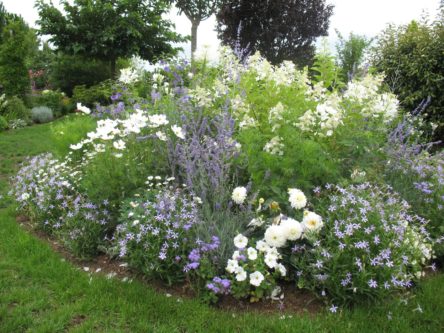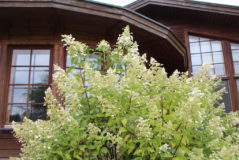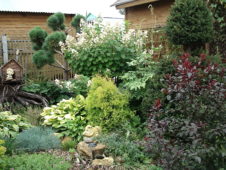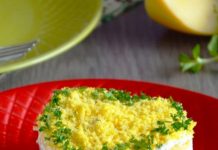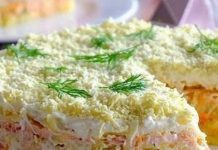Hydusia kiushu is the embodiment of grace and airiness. She looks great in any style decision of landscape design, striking with her, like lace, panicle inflorescences. This plant has many admirers among flower growers, and for good reason. This unpretentious shrub is luxurious and blooms all summer long, delighting lovers with wonderful splendor and aroma.
Material Content:
Description
Panicled hydrangea Kyushu is an ornamental shrub of three meters high with a dense spreading crown. She has smooth, tall branches of a brownish-red color. The oval-shaped leaf plate has a length of 12 cm, maroon cuttings. The leaves are slightly pubescent with a saturated green hue, more on the back side, the longest and thickest hairs are located along the veins and cuttings.
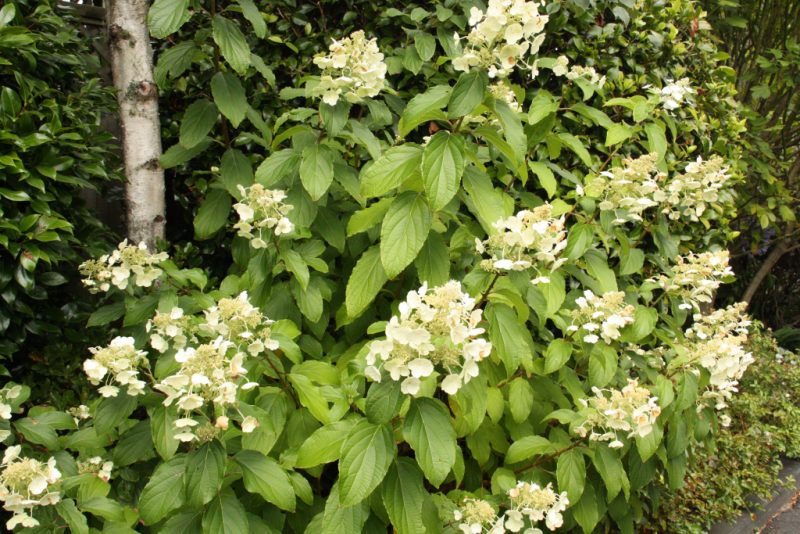
The variety has magnificent pyramid-shaped inflorescences dazzlingly white. With the onset of autumn, they change their color, becoming slightly pinkish. The flowers themselves in inflorescences are small, up to three centimeters in diameter, have four petals. Exude a bright aroma with notes of honey. There are fertile flowers that can produce seeds.
True, young plants do not bloom for long, only in the fifth year lush inflorescences begin to blossom. Flowering begins in late June, and ends by October. Therefore, for landscape design hydrangea kiushu is a very fertile material.
Hydrangea is able to live long, grow rapidly, is not afraid of winter frosts, can withstand even cold at thirty degrees. A healthy plant tolerates drought well, but is extremely moisture-loving.An additional positive quality - it tolerates the urban atmosphere, saturated with the exhaust gases of road transport.
A transparent lace shadow or partial shade is more suitable for Kyushu, under such conditions the plant will stretch upward, and the inflorescences will appear in full force. This type of hydrangea is also able to grow in sunny space, however, you should not expect from it in such conditions of powerful flowering. The flowers will be small, the shoots are not as high as you want.
Hydrangeas are suitable acidic soils of clay origin. The higher the acidity of the soil, the more beautiful will be the panicles of flowers. Sandy soils are not suitable for her, as are acid neutral ones.
This plant will adorn both the city park and the house adjoining site.
Seed selection and hydrangea planting in open ground
The birthplace of hydrangea, including Kyushu, is China and Japan. Therefore, ordering seeds from China is quite appropriate. You can also collect seeds from fertile flowers; they look small and not very beautiful, however, fertile. Bright lush flowers do not produce seeds.
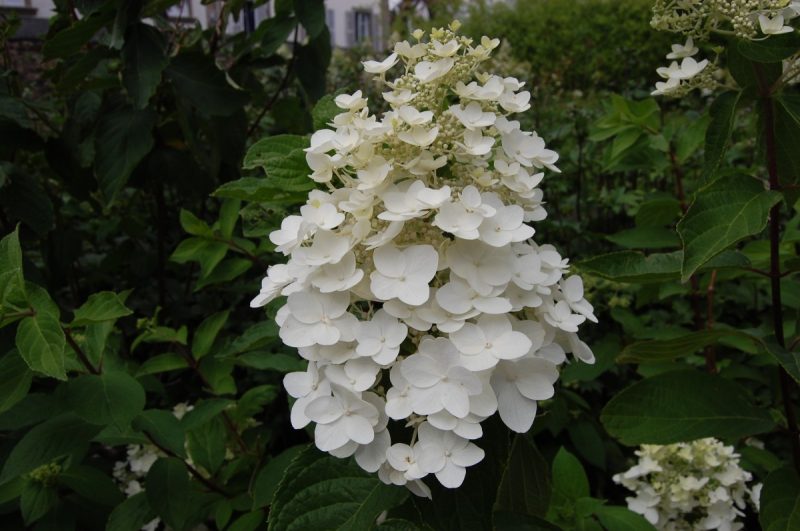
The seeds themselves should not be damaged, even in shape. In the event that the seed came to you on request slightly moist, then you can dry it a little in the oven. Be sure to pre-disinfect the seeds before planting in a solution of copper sulfate or potassium permanganate.
In February, seedlings are prepared, seeds are first germinated on wet gauze, moistened with a spray gun. Then the plant is planted in pots, you can peat. The care is usual, as well as for other indoor flowers. The main thing is that young hydrangeas do not like direct sunlight. For them, diffused, but quite bright lighting is suitable. Along with watering, it is sometimes useful for kiushu seedlings to spray them from the spray gun. They love acidified water. Twice a month, you can feed the soil with mineral fertilizers.
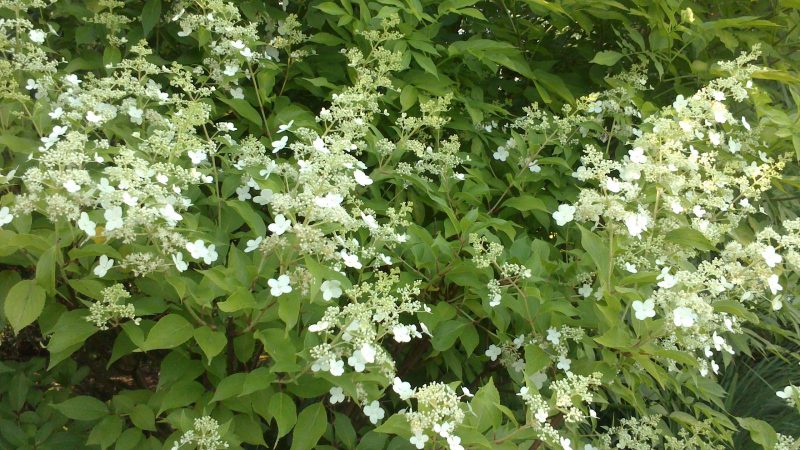
Before planting seedlings in open ground, you need to choose the right place for them. It must be protected from hot sunlight and wind. The place near the wall of the house, where snow in the winter can crash from the roof and break the fragile branches of the plant, will also not work.
Acidic soils are suitable for hydrangea. However, even unsuitable soil can be adapted for kiushu. To do this, use special mineral fertilizers that can acidify the earth. Watering with acidic water, diluting lemon juice in it, the remains of fermented milk products, table vinegar.
Hydrangea kiushu planting in open ground occurs in early spring, when the earth warms up. A small and not very deep hole is prepared under the bush, up to seventy centimeters in diameter. The roots of this plant grow in width, not in depth. At the bottom put drainage material - pebbles, pieces of brick. When kiusha is planted on sandy soil, the clay layer will play the role of drainage.
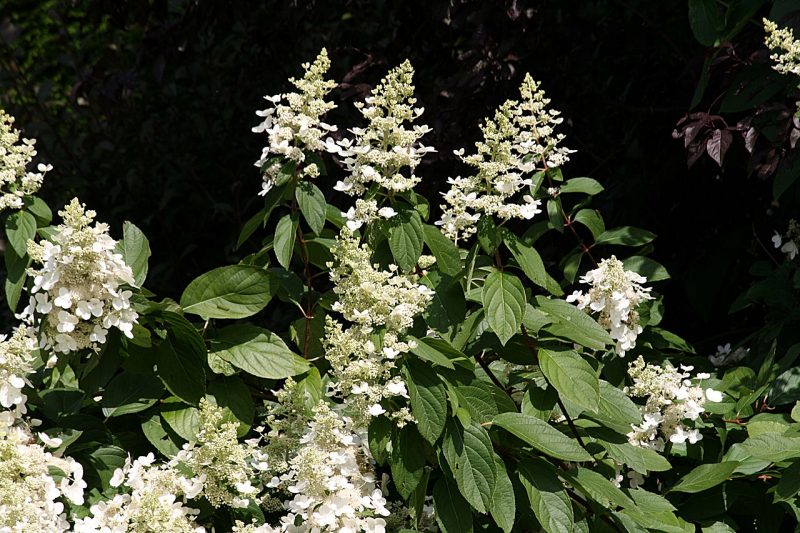
Next, a little sprinkle the pit with a good nutritious mixture, place a seedling in it so that it is convenient to spread the roots. They add more soil, do not need to deepen the plant too much, the neck should be flush with the surface. Water the seedling and sprinkle compost, peat with a good enough layer, eight centimeters.
Care for hydrangea panicled Kyushu
Panicled hydrangea kiushu blooms very powerfully and brightly, grows rapidly, so it needs a large amount of nutrients, both organic and mineral origin. It is worth feeding the plant regularly.

Pay attention to water quality. It should be soft, ideally rain. We must not forget that hydrangeas should be watered often and plentifully.
Feeding for hydrangea is also necessary, moreover, from the earliest spring. Under each bush you need to pour a couple of buckets of water with urea. About twenty grams of fertilizer should be added to the bucket.
All summer the plant needs potash and phosphorus fertilizers. This recharge is carried out twice a month.In specialized stores you can find special mixtures that are designed for hydrangea. They can be supplemented with humus.
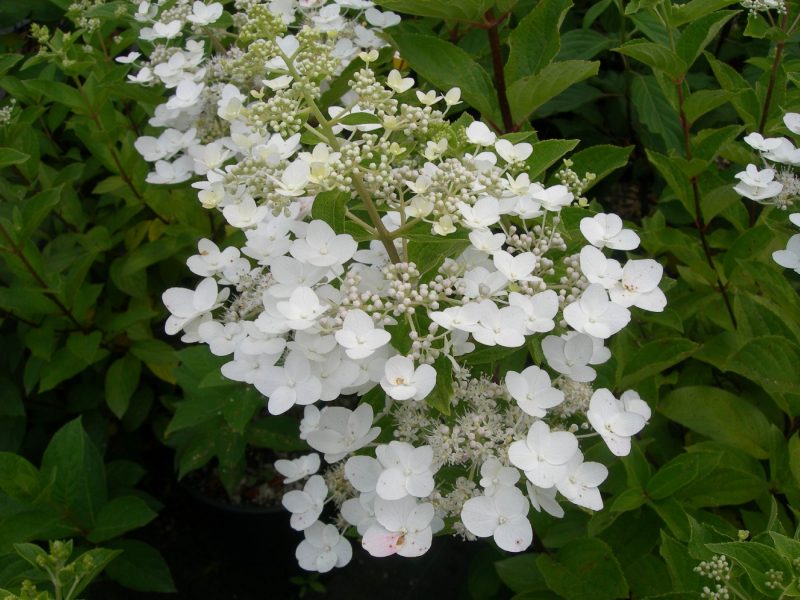
In autumn, preparing the plant for winter, water the soil with a mixture of potassium sulfate and superphosphate in order to strengthen its immunity to the coming cold.
Trimming hydrangeas is carried out every year, because it stimulates the appearance of beautiful and lush inflorescences. In the spring, while the buds have not yet blossomed, the dry ends of the branches that have not survived the winter are removed. Annual shoots are slightly pruned, up to five pairs of buds. Then the flowers will be larger.
Old shoots can be rejuvenated, the plant will restore a beautiful crown the very next year.
It is interesting:hydrangea home: care
Protection against diseases and pests
Almost all types of hydrangea are quite unpretentious in content. They do not require special care, and yet, there are diseases and pests that even a plant with good immunity will not be able to cope on its own.

First of all, these are environmental factors: with excessive sun and drought, the leaves of the plant turn yellow, become dry and fall off. There is only one “medicine” - good watering and additional fertilizing with mineral fertilizers.
However, it happens and vice versa, the plant suffers from excessive moisture. The so-called wet blackening of leaves appears. Accordingly, the bush should be watered less often.
Hard water is another traditional cause of trouble. Hydrangea loves soft water, slightly acidified. It is not always worthwhile to use special means, just to defend the moisture prepared for irrigation, so that suspended in water settled on the bottom of the tank.
Adverse factors may be improperly selected soil, climatic conditions with large temperature differences and winds. Accordingly, the landing site should be chosen with a more stable temperature regime and protected from the wind.
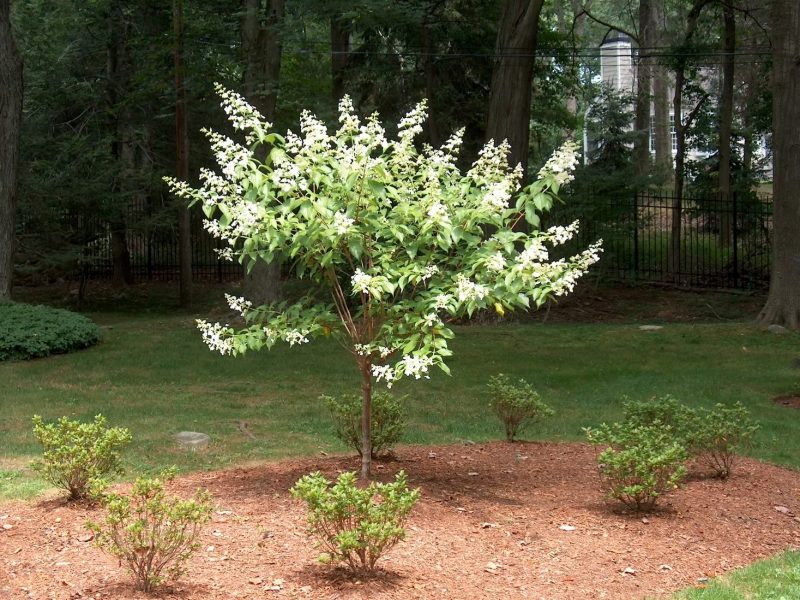
The diseases that affect hydrangea are not numerous:
- Chlorosis - is expressed in the fact that the leaves between the veins lighten in the plant. This is a signal of serious distress. The reason is too fresh soil and lack of iron. It is possible to acidify the soil using irrigation water, to which 4 g of citric acid per liter is added. The iron deficiency is compensated by using vitriol, which is also dissolved in water for irrigation at the rate of 3 g per liter.
- Gray rot - looks rather unpleasant. The leaves become covered with dark spots, ulcerate. This is a fungal disease that is usually not easy to get rid of. First of all, remove all affected leaves. Dig a bush so that the infection does not spread to the still healthy parts of the plant. Repeatedly spray with a solution of copper and soap. Treatment lasts at least two weeks.
- Septoria is brown spots on leaves about five millimeters in size. This progressive disease can completely deprive hydrangea of all leaves, as over time they simply fall off. It is necessary to cut off all affected areas, collect fallen leaves, so as not to spread the infection further. Spray the plant in spring with a Bordeaux mixture.
- Rust - leaves become rusty. This problem is solved by spraying with copper chloride in a proportion of 20 g per 5 liters of water.
In addition to diseases, hydrangea can suffer from pests:
- Aphids - an ordinary stream of water will help get rid of it. Only when watering it is necessary to regulate the flow of fluid so as not to harm the plant itself. Where it was not possible to wash off the aphids, insecticides are used. The natural enemies of aphids are ladybugs.
- Spider mite - usually this pest settles on the back of the leaves of the plant, it is easy to spot it on the web, which it entangles the stems. You can destroy the tick with the help of Fufan and Thiophos preparations.
- Slugs - they are found where plants are too close to each other. Solves the problem of mollyuksotsidom. This tool is scattered on the ground in the habitats of slugs.
Preparing the plant for wintering
Young plants of Kyushu should be covered for the winter. The procedure is simple - the stems are bent to the soil, strengthened so that they can not straighten. Then cover with a special fiber or spruce branches. Around the roots fertilize the soil with peat, humus can also be used.
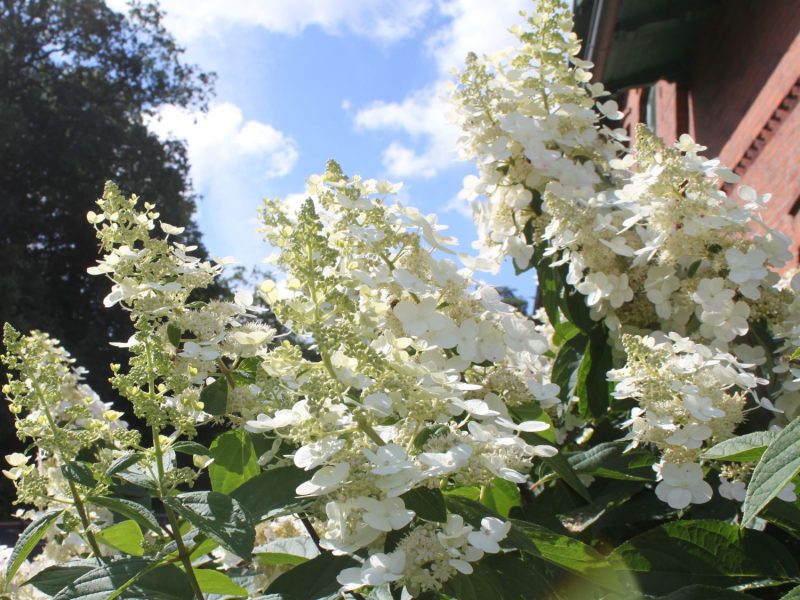
First-year seedlings should be especially prepared for the winter period. They will need all the strength to survive in the cold season. Therefore, all inflorescences should be removed from them.
Adult kiushu plants are quite resistant to frost. Their branches should be tied up and fixed on a support so that they do not break under the load of snow and wind.
Superphosphate is suitable for the last feeding of the plant before wintering.
In spring, work will be done on trimming hydrangeas, this will make new shoots grow faster, and the inflorescences will become larger and more magnificent.
Methods of propagation of hydrangea Kyushu
There are two main ways of propagating hydusia kiushu. Both are quite effective, and the choice depends only on the preference of the gardener and the time of year.
Method 1. Offsets
In early spring, as soon as the buds begin to bloom, gardeners begin to propagate hydrangea by layering. This will require that the plant has already grown on the site. Furrows are dug near the bush, the lower branches are laid in them, sprinkled with earth. You should try so that they do not rise from the ground, straightening.
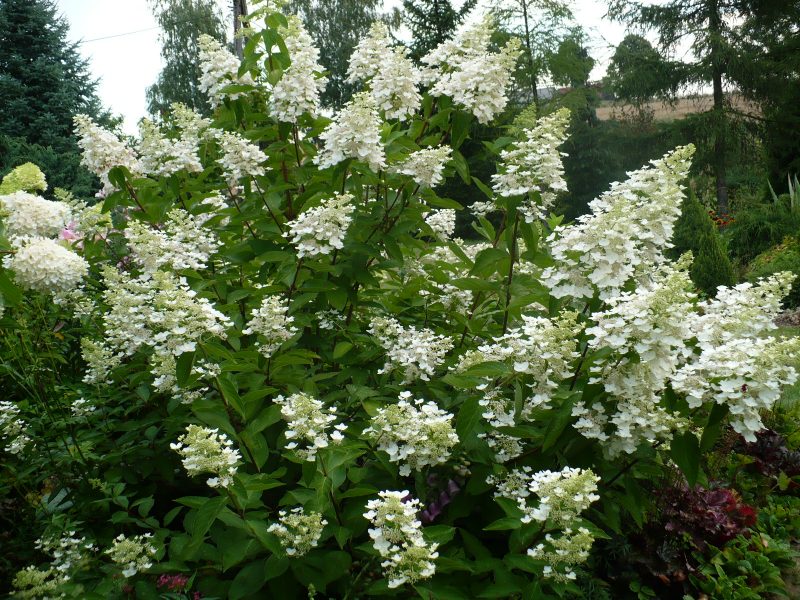
The first processes from these dug up branches will go at the end of summer. When they reach a height of 15 cm, they will need hilling once a week. The procedure should be repeated until the new beginnings of hydrangea bushes are 30 cm high.
In October, dig out the cuttings, then carefully separate the new shoots and plant them as independent plants. In the spring they will need to be transplanted to well-fertilized and loosened beds. Only in a year panicle hydrangea will be fully formed, and young plants can already be transplanted to a chosen place in the garden.
Method 2. Cuttings
In the very middle of summer, hydrangea kiushu is propagated by cuttings. Usually they are cut off from young, full of plant forces. In these green, juicy stems, the buds should already be well developed.
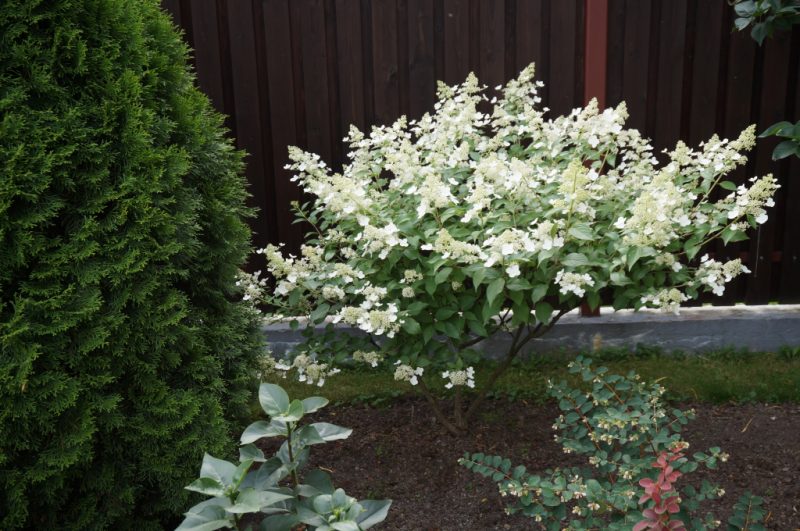
It is better to work with cuttings at that time of the day when they have accumulated maximum moisture in themselves, and this happens in the morning. Each cut branch should be cut into several parts so that at least two leaves remain on each of them. The topmost part of the shoot is unsuitable for reproduction, so it is usually thrown away. The lower leaves are removed, the upper ones are cut to half.
Ready cuttings are placed for a couple of hours in a solution of the stimulator, so that the roots begin to form faster. Then planted in a special wet mixture consisting of sand and peat. So cuttings are left until autumn, covering for the winter. In the spring, transplanted for growing on a fertilized bed.
Application in garden design
Panicled hydrangea looks great in a single planting, decorating the core of the garden.
Another method in landscape design where it can come in handy is zoning. When the whole territory is divided into separate zones, each with its own purpose. Hydusia kiushu is perfect as a border plant that separates one zone from another.
From panicled hydrangea, luxurious hedges are also obtained, which separate secluded corners from prying eyes in the garden.
Kyushu will find application for decorating gazebos, lovely garden benches. However, the most luxurious place is at the reservoir, where beautiful flowers and unusual leaves will be beautifully reflected in a quiet mirror of standing water.


